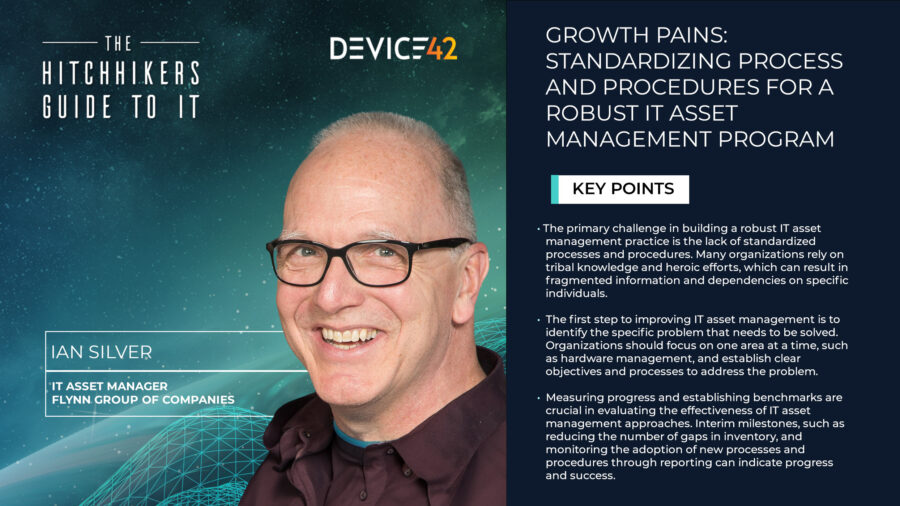Many enterprises use IT asset management solutions and standardized processes to manage their fast-growing hardware and software asset portfolios. Using standardized, automated processes enables teams to create a single version of truth for all assets, improve their utilization, drive ROI on IT spend, and enhance security by monitoring and maintaining all solutions. Teams also work more productively, because automated processes are easier to maintain than manual ones, eliminate error and rework, and help prevent the fire drills previously caused by inaccurate, incomplete asset information.
Purpose of This Blog
The purpose of this blog is to encourage IT professionals to evolve IT asset management practices, moving from spreadsheets and manual processes to an automated system that provides standardized management and monitoring processes.
Recently, podcast host Michelle Dawn Mooney welcomed Ian Silver to The Hitchhiker’s Guide to IT to discuss the importance of standardizing IT asset management (ITAM) processes and procedures. Ian Silver is the IT asset manager for the Flynn Group of Companies, a leading commercial roofing and cladding contractor in North America. Ian previously held multiple positions in IT, serving as a programmer, database administrator, system integrator, and program manager.
Defining IT Asset Management
Host Mooney asked her guest to define ITAM. Silver said ITAM involved the cradle-to-grave financial and operational management of all hardware and software.
ITAM involves “making sure that things are up and running, and also tracking the
value proposition, so [teams can optimize] costs and the value of those assets throughout their lifecycle. [It includes] selecting the assets, getting them up and running into production, looking after refresh frequencies, [maximizing] opportunities for optimization, and … retiring and disposing of assets,” said Silver.
Read:
ITAM vs. CMDB – What are the Differences?
5 Quick Tips For Effective IT Asset Management
ITAM Accuracy: A Foundation for Business Effectiveness
Challenges Companies Face Building an ITAM Practice
Silver said that the biggest challenge companies face when they don’t have a formal ITAM practice is that talented people rely on “tribal knowledge” and use “heroic efforts” to manage their asset bases.
“What ends up happening is that information is fragmented and siloed across the organization. Then if somebody leaves, you really start to understand just how dependent you are on this fragile web of these heroic users who are keeping things afloat. And so the challenge is how do you move from that to something that’s standardized, repeatable, and can be then used by anyone across the organization with the proper [training],” Silver said.
Roadmap for Establishing an ITAM Practice
Host Mooney asked Silver how an organization would go about setting up an ITAM practice. Silver recommended:
- Defining the problem you’re trying to solve: Instead of just trying to make IT asset management better, teams should identify the pain points they’re trying to solve.
We “had challenges around managing our hardware… [Laptops] wear out, because they get heavy duty use or they just get old and need to be replaced. So we’ve gotta track those. We’ve got lots of servers and other network infrastructure that age over time and have to be replaced, and we have to be able to manage that. So for us, that was the first problem. We need to get a better handle on our hardware and how do we go about getting that data together,” Silver stated. - Align around desired processes and procedures: Before evaluating ITAM tools, teams should discuss and align around the processes and procedures they want to use. That way, they can map data to established processes and procedures, rather than collecting data and trying to reverse-engineer it into processes and procedures. Silver said his team made that mistake. “We got the cart ahead of the horse there.”
The danger of not taking time upfront to set up a workable structure is that people focus on technology features, rather than process change. “The challenge there is that you can get easily distracted by lots of shiny things in the tools that you deploy, that maybe aren’t part of the core problem you’re trying to solve. And so you can end up off on a tangent here or there working on things that really aren’t helping you move forward on what your core vision is,” said Silver.
Creating Benchmark Data to Measure Results
So, how do teams know if their ITAM processes are actually driving business value? Silver recommended setting up benchmarks such as:
- Creating interim milestones: IT teams typically need to close gaps between how they should be managing assets and where they are today. So, they can create interim milestones focused on remediation, which includes building out process and procedure changes and improving reporting. With better reporting, teams can communicate updates on their progress.
Silver gave the example of a centralized ITAM inventory that doesn’t match the current state of the IT asset base at 30 locations across North America. “So how do we close those gaps? So we start building out some reporting that says, ‘Hey, our gap is ten thousand mistaken or mismatched devices,’ and then we can start reporting on reducing that number and the progress we’re making on that,” he said.
Key Takeaways for Improving IT Asset Management
Host Mooney asked Silver to provide key takeaways on creating and evolving leading ITAM capabilities. Silver said.
- Solve the right problems: “The tools that you select are there to support objectives that you’ve already identified, not the reverse,” he said.
- Don’t boil the ocean: “If you try to do it all at once, you will fail. You have to measure those little successes. You know, take time to identify those incremental wins because they will add up to something,” said Silver, comparing improving ITAM capabilities to learning to play the piano or the guitar.
- Understand that change is difficult. “Some things are gonna get worse before they get better…. You’re introducing a whole lot of new stuff. People have to learn new ways, they have to learn a new tool, they have to learn new procedures…. Folks who knew this stuff and were succeeding with those heroic efforts … they can’t do [it] that way [anymore]. And so, some of your current experts will become less productive in the short term as you start to introduce these new standardized ways of doing things, and you need to be okay with that,” stated Silver.
- Get ready to scale: “A phrase I like to use is go slow now to go faster later. You know, be willing to make sure that you’ve got buy-in from the top down to take the hit on productivity now to successfully make the transition to the standard repeatable process approach that everybody is gonna wanna see down the road,” he said.




